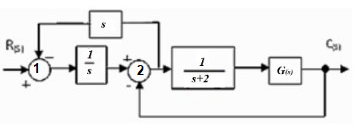Let G(s)-7.6s. Obtain the over-all transfer function, then substitute s=1. Give the calculated value in 3 decimal places. ਪਰ 8+2 R51 Civ Cal
Let G(s)-7.6s. Obtain the over-all transfer function, then substitute s=1. Give the calculated value in 3 decimal places. ਪਰ 8+2 R51 Civ Cal
Introductory Circuit Analysis (13th Edition)
13th Edition
ISBN:9780133923605
Author:Robert L. Boylestad
Publisher:Robert L. Boylestad
Chapter1: Introduction
Section: Chapter Questions
Problem 1P: Visit your local library (at school or home) and describe the extent to which it provides literature...
Related questions
Question
Please help me answer these problems. Hope you can share your solutions as well. Thank you!
Please answer in typing format please ASAP

Transcribed Image Text:**Transcription and Analysis for Educational Purposes**
---
**Problem Statement:**
Let \( G_{f(s)} = 7.8s \). Obtain the overall transfer function, then substitute \( s = 1 \). Give the calculated value to three decimal places.
---
**Block Diagram Description:**
The system is represented by a block diagram consisting of:
1. **Input (\( R_{s1} \))**: The system starts with an input signal.
2. **Summation Junction 1**: This takes in the input \( R_{s1} \) and the feedback loop, which is defined later.
3. **Transfer Block 1** (\( \frac{1}{s} \)): This block represents an integrative action where the input function is multiplied by \( \frac{1}{s} \).
4. **Transfer Block 2** (\( s \)): The output from the integrative action is multiplied by \( s \).
5. **Summation Junction 2**: This junction adds the output from Transfer Block 2 and the output from the previous summation, which had been integrated.
6. **Transfer Block 3** (\( \frac{1}{s+2} \)): This block further processes the signal by dividing it by \( s+2 \).
7. **Transfer Block 4** (\( G_{f(s)} = 7.8s \)): This block applies the given function \( G_{f(s)} = 7.8s \) to the output of Transfer Block 3.
8. **Output (\( C_{s1} \))**: The processed signal is now the output \( C_{s1} \).
The feedback loop intersects at the first summation junction from the output of Transfer Block 1.
---
**Procedure:**
1. **Determine Overall Transfer Function**: Compute the overall transfer function based on the series and parallel connections in the block diagram.
2. **Substitute \( s = 1 \)**: Once the overall transfer function is derived, substitute \( s = 1 \) into the function.
3. **Calculate and Round the Value**: Perform the calculation and round the result to three decimal places, providing the final output.
Having a thorough understanding of Laplace Transforms and system dynamics is crucial to solving this problem and deriving the overall transfer function accurately.
Expert Solution
Step 1: Question analysis:
Given: obtain the overall transfer function then substitude s=1.Answer the value in 3 decimal places.

- Let us reduce the block diagram by using block diagaram reduction method.
Step by step
Solved in 4 steps with 10 images

Knowledge Booster
Learn more about
Need a deep-dive on the concept behind this application? Look no further. Learn more about this topic, electrical-engineering and related others by exploring similar questions and additional content below.Recommended textbooks for you

Introductory Circuit Analysis (13th Edition)
Electrical Engineering
ISBN:
9780133923605
Author:
Robert L. Boylestad
Publisher:
PEARSON

Delmar's Standard Textbook Of Electricity
Electrical Engineering
ISBN:
9781337900348
Author:
Stephen L. Herman
Publisher:
Cengage Learning

Programmable Logic Controllers
Electrical Engineering
ISBN:
9780073373843
Author:
Frank D. Petruzella
Publisher:
McGraw-Hill Education

Introductory Circuit Analysis (13th Edition)
Electrical Engineering
ISBN:
9780133923605
Author:
Robert L. Boylestad
Publisher:
PEARSON

Delmar's Standard Textbook Of Electricity
Electrical Engineering
ISBN:
9781337900348
Author:
Stephen L. Herman
Publisher:
Cengage Learning

Programmable Logic Controllers
Electrical Engineering
ISBN:
9780073373843
Author:
Frank D. Petruzella
Publisher:
McGraw-Hill Education

Fundamentals of Electric Circuits
Electrical Engineering
ISBN:
9780078028229
Author:
Charles K Alexander, Matthew Sadiku
Publisher:
McGraw-Hill Education

Electric Circuits. (11th Edition)
Electrical Engineering
ISBN:
9780134746968
Author:
James W. Nilsson, Susan Riedel
Publisher:
PEARSON

Engineering Electromagnetics
Electrical Engineering
ISBN:
9780078028151
Author:
Hayt, William H. (william Hart), Jr, BUCK, John A.
Publisher:
Mcgraw-hill Education,